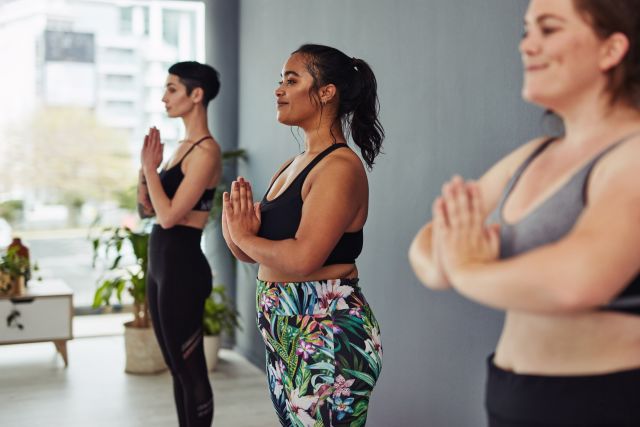Updated on November 30, 2022.
A lot of people wish they could change something about their body—less of this, or more of that. Sometimes, it’s a moving target. What you wish you had today may be different from what you wanted a few years ago or what you may want down the road.
It’s a common theme. Most Americans report feeling dissatisfied with their bodies from time to time, with only about 20 percent reporting that they like their body just the way it is. Some admit they’d go through great lengths to achieve a different physique. In fact, about three-quarters of adults say they would give up something they love, such as alcohol, pizza—even sex—if it meant they could have a “perfect” body overnight, according to a 2018 survey by the public affairs company Ipsos.
But what is the “perfect” body? How you define this depends on a slew of variables, including the corner of the world in which you live, the media messages you’re receiving at any given time, how you were raised, and your life experiences. Complicating matters, how you think and feel about your body may be distorted, or not always line up with how it appears. Those perceived flaws that seem so apparent to you may not be noticeable to others. Some people may even find your “flaws” enviable.
That’s because body image is subjective, explains Rachel Rodgers, PhD, an associate professor in the department of applied psychology at Northeastern University in Boston who specializes in the sociocultural influences on body image. And just as you work on having healthy relationships with the people around you, you can also be intentional about cultivating a healthy relationship with yourself—and your body—to help bolster your self-esteem and protect your mental and physical well-being.
Making peace with your body
The first step is to understand the many factors that help shape your body image. This inside view of how you see yourself includes more than simply your size, weight, and shape. Your body image is also defined by your opinion of your appearance and how you feel in your own skin. Self-esteem, memories, daily habits, grooming, assumptions, and stereotypes may all contribute to your body image.
While bone structure, body size, shape, and weight may be influenced by your DNA, your culture, racial identity, and ethnicity may also interact with how you think and feel about your body. One 2019 study published in Social Work Research compared various aspects of body image in African American, white, Asian American, Hispanic/Latina and multiracial American women. Overall, the study showed the African American participants had the highest body appreciation, and that favorite and least favorite body parts varied by race and ethnicity. For example, those who identified as African American valued lip thickness while white participants appreciated eye color. Those who self-identified as Asian or Latina favored hair.
A separate 2020 study published in Body Image also looked at perceptions of body positivity among female university students in eight European countries. The study’s results showed that body positivity was highest in Bosnia and Herzegovina, Croatia, and Israel—where the cultural ideal body size tends to be larger and more realistic—and lowest in Belgium, Finland, and Ireland.
Societal pressures that dictate ideal body shapes, being criticized (or bullied) about your appearance, and being classified as underweight or overweight are all experiences that can negatively influence your body image and self-esteem. Mental health issues, such as depression and eating disorders, can also undermine your self-worth, which may spill over into other areas of your life and contribute to poor academic or job performance as well as unhealthy relationships.
Learning to like your body—or simply accept and respect it—can improve your health and overall quality of life, according to Rodgers. “Positive body image, or body neutrality have been shown to be associated with improved well-being, and may be protective of mental health concerns,” she says.
What it means to be body positive—or neutral
Body positivity is a social movement with roots in the 1960s, when ideals about beauty standards began to be challenged. Body positivity involves accepting all body types and loving your body and being proud of it regardless of its shape, size, color, skin tone, or physical ability.
“Positive body image involves holding positive and accepting feelings towards the body as well as engaging in behaviors oriented towards self-care and protection from appearance pressures,” Rodgers says.
While body positivity may help you focus on positive thoughts and chip away at self-criticism, it may not be for everyone. Some people may feel like they’re pretending, and that loving their body unconditionally may be unrealistic for them. For others, forcing positive thoughts or burying negative feelings may backfire, triggering negative emotions like shame, guilt, and anxiety, or contribute to depression.
One answer to that is body neutrality. A middle of the road approach, body neutrality focuses on nurturing a healthier body image by prioritizing what your body can do—not how it looks. Those who adopt a body neutral stance accept their body, respect it, and treat it with kindness. For those who choose this path, their value and happiness do not depend on how they look, Rodgers explains.
“Body neutrality is a stance that differs from body positivity slightly, in that it emphasizes the importance of decentering the body and appearance and focusing on other aspects of an individual,” she says.
Tips to cultivate a healthier body image
It’s likely that few people feel completely satisfied with every part of their body 100 percent of the time, but you can take steps to cultivate a healthier body image. Rodgers advises trying some of the following strategies to help you accept and appreciate your body:
Strive for balance. How you feel about your body may change over time. Allow yourself to shift between body positivity and neutrality, depending on what feels authentic and comfortable for you. But if you are leaning towards a neutral stance, remember to focus on what your body can do and how it enables you to laugh, breathe, dream, and perform other activities you enjoy.
Practice shifting your mindset. Learning to accept, appreciate and respect your body may take time. Some things you can do to help you adopt a more positive or neutral view:
- Look at yourself as a whole person—not individual or specific body parts.
- Choose clothing that makes you feel good or comfortable.
- Make time for self-care. Try to get enough rest and fuel your body with a variety of balanced, healthy meals.
- Setting appearances aside, make a list of all your accomplishments, and the inner qualities that make you a good person.
Get regular exercise. A 2016 study published in Neuropsychiatric Disease and Treatment found that physical activity is associated with greater self-esteem. The U.S. Department of Health and Human Services recommends that otherwise healthy adults get 150 minutes of moderate-intensity physical activity each week (like brisk walking) and do muscle-strengthening activities (like push-ups or sit-ups) on two or more days each week). If your mobility is limited, it's still important to move as much as you are able and avoid inactivity. Gaining strength and fitness can also help you appreciate what your body can do—not simply how it looks.
Be kind to your body. Recognize when you may be pushing yourself too much, and when you need to rest and refuel. Excessive or compulsive exercise (which interferes with your life or activities) can lead to burnout, injury, and increase the risk for health problems, including joint pain, bone density loss, or problems with your immune system.
Avoid obsessing about the numbers on your scale. It’s a good idea to monitor your weight for unexpected gains or losses. But if stepping on a scale doesn’t serve you—it fosters anxiety, lack of motivation, or poor self-esteem—use it less often. Even if you use the same scale each day, your weight can fluctuate due to things like water intake, shifting hormones, and your activity level. And remember there is no ideal body weight. The best weight for you is “the weight that allows you to feel strong and energetic and lets you lead a healthy, normal life,” according to the National Eating Disorders Association.
Try to be more mindful. Aim to focus more on the present, listen to your body, and be more aware of how you talk to yourself. Respect the cues your body is giving you (when it’s hungry, full, tired, sore, etc.), and make sure your inner voice uses nonjudgmental language. Give yourself the same care and consideration that you’d give a friend or loved one.
Avoid the comparison trap. Resist the urge or pressure to judge and compare yourself to others, including those in your life (friends, family, co-workers, neighbors) and those you’ve never met (models, influencers, celebrities, athletes). Instead, reach out and volunteer your time. Finding purpose by helping others can interrupt negative or critical thought patterns.
Limit your exposure to negative media. If your social media feeds, favorite TV shows, or magazine subscriptions leave you feeling more critical of your body, it’s time to shift your attention elsewhere. To be sure, many media images aren’t even reflective of reality as they’ve been edited, filtered, or otherwise adjusted with computer technology. “These images are typically excessively lean and toned or muscular, and very different to the body shapes of the majority of individuals,” Rodgers says. “Achieving such a body shape is not realistic for most people through healthy means. The result is strong pressures to pursue unrealistic appearances, as well as perpetuating a system in which only certain bodies are valued.”
Seek out support and diversity. Body-positive media can help bolster people’s self-esteem. Try to surround yourself with positive images and people who support and accept you. Exposure to a more diverse range of bodies in the media is also “critical” to broadening ideas about beauty and easing pressure to conform to unrealistic ideals, Rodgers argues. “Increasing the inclusivity and diversity of bodies depicted in images is an important step towards supporting positive body image,” she says.
Consider talk therapy or CBT (cognitive behavioral therapy). This commonly used form of therapy can help you become more aware of negative thought patterns and learn new ways of thinking. CBT has been shown to improve symptoms of mental health conditions, including eating disorders, depression, and anxiety. But it can also help just about anyone feel better and improve their well-being.







